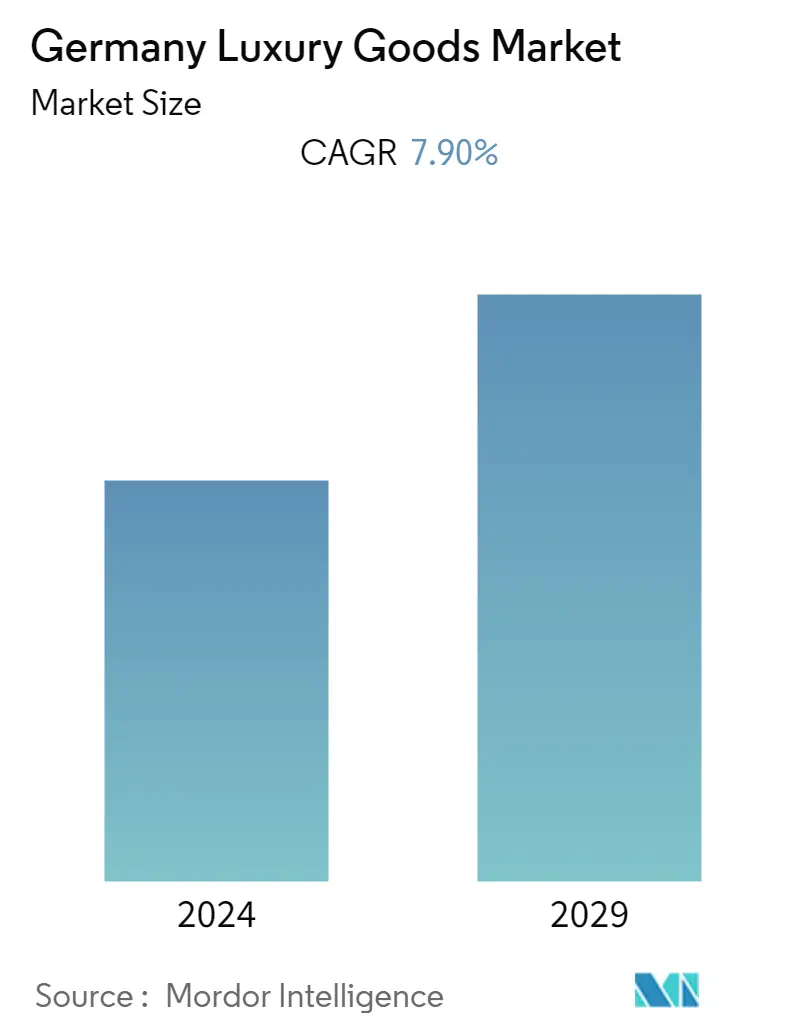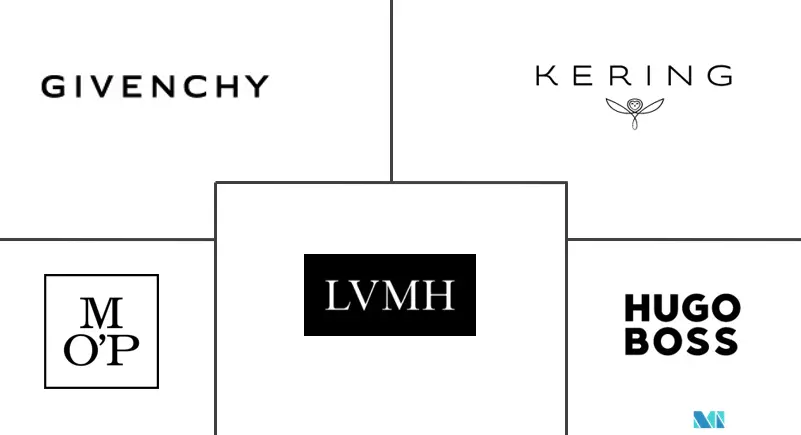Market Size of Germany Luxury Goods Industry

| Study Period | 2019 - 2029 |
| Base Year For Estimation | 2023 |
| Forecast Data Period | 2024 - 2029 |
| Historical Data Period | 2019 - 2022 |
| CAGR | 7.90 % |
| Market Concentration | Low |
Major Players
*Disclaimer: Major Players sorted in no particular order |
Need a report that reflects how COVID-19 has impacted this market and its growth?
Germany Luxury Goods Market Analysis
Germany luxury goods market is projected to grow at a CAGR of 7.9% during the forecast period (2022-2027).
During the COVID-19 pandemic, the demand for luxury goods diminished drastically as stores remained closed under lockdown regulations and international travel was also restricted. Further, the financial crisis due to the rise in unemployment added to the decline in the luxury goods market during the pandemic.
Further, the pandemic has highlighted the importance of e-commerce and social media marketing for effective brand communication, which in turn has enabled luxury goods companies to recover from demand disruption. Additionally, key industry players have restructured their digital marketing strategies to compensate for the closure of brick-and-mortar stores. For instance, Hugo Boss reported in its annual report that the company had a 66% rise in its online sales during the fourth quarter of the financial year 2020.
Moreover, the upscale malls in the region like Aquis Plaza, Gesundbrunnen-Center, and Westfield Centro, among others have offered luxury brands ample space to expand their operations in the country. This, in turn, is anticipated to drive growth in the luxury goods market during the forecast period.
Germany Luxury Goods Industry Segmentation
Luxury goods are premium-priced products that are often linked with affluent people and serve as symbols of social status. Germany luxury goods market is segmented by type and distribution channel. By type, the market is segmented into clothing and apparel, footwear, bags, jewelry, watches, and other accessories. By distribution channel, the market is segmented into single-brand stores, multi-brand stores, online stores, and other distribution channels. The report offers market size and forecasts in value (USD million) for the above segments.
| By Type | |
| Clothing and Apparel | |
| Footwear | |
| Bags | |
| Jewelry | |
| Watches | |
| Other Accessories |
| By Distibution Channel | |
| Single-brand Stores | |
| Multi-brand Stores | |
| Online Stores | |
| Other Distribution Channels |
Germany Luxury Goods Market Size Summary
The Germany luxury goods market is anticipated to see considerable growth in the coming years. The COVID-19 pandemic initially caused a significant decrease in demand due to store closures and travel restrictions, but the industry has been able to recover through the increased use of e-commerce and social media marketing. High-end malls have provided luxury brands with the opportunity to expand their operations, which is expected to drive market growth. Major players in the industry have also adapted their digital marketing strategies to compensate for the closure of physical stores. Trends in the German luxury goods market include a booming e-commerce fashion retail sector and a rising demand for sustainable luxury goods. The country is one of the largest e-commerce markets in Europe, with clothing being a popular online purchase. The shift in consumer behavior due to the pandemic has driven the online sale of luxury goods. Additionally, consumers are increasingly interested in sustainable fashion, leading manufacturers to invest in the development of eco-friendly and ethically made products. The market is fragmented with many international and local players, and brands are investing in new product development, strategic partnerships, and collaborations to expand their distribution networks.
Explore MoreGermany Luxury Goods Market Size - Table of Contents
-
1. MARKET DYNAMICS
-
1.1 Market Drivers
-
1.2 Market Restraints
-
1.3 Porter's Five Force Analysis
-
1.3.1 Threat of New Entrants
-
1.3.2 Bargaining Power of Buyers/Consumers
-
1.3.3 Bargaining Power of Suppliers
-
1.3.4 Threat of Substitute Products
-
1.3.5 Intensity of Competitive Rivalry
-
-
-
2. MARKET SEGMENTATION
-
2.1 By Type
-
2.1.1 Clothing and Apparel
-
2.1.2 Footwear
-
2.1.3 Bags
-
2.1.4 Jewelry
-
2.1.5 Watches
-
2.1.6 Other Accessories
-
-
2.2 By Distibution Channel
-
2.2.1 Single-brand Stores
-
2.2.2 Multi-brand Stores
-
2.2.3 Online Stores
-
2.2.4 Other Distribution Channels
-
-
Germany Luxury Goods Market Size FAQs
What is the current Germany Luxury Goods Market size?
The Germany Luxury Goods Market is projected to register a CAGR of 7.90% during the forecast period (2024-2029)
Who are the key players in Germany Luxury Goods Market?
Kering SA , LVMH Moët Hennessy-Louis Vuitton SE , HUGO BOSS AG , Givenchy and Marc O’ Polo Group are the major companies operating in the Germany Luxury Goods Market.

